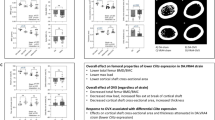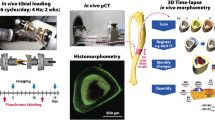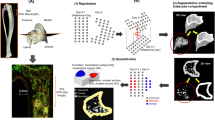Abstract
Bone loss due to age and disuse contributes to osteoporosis and increases fracture risk. It has been hypothesized that such bone loss can be attenuated by modulation of the C–C chemokine receptor 2 (CCR2) and/or its ligands. The objectives of this study were to examine the effects of genetic elimination of CCR2 on cortical and trabecular bones in the mouse tibia and how bone loss was impacted following disuse and estrogen loss. Female CCR2 knockout (CCR2−/−) and wildtype mice underwent ovariectomy (OVX) or denervation of musculature adjacent to the tibia (DEN) to induce bone loss. Cortical and trabecular structural properties as well as mechanical properties (i.e., strength) of tibial bones were measured. Compared to wildtype mice, CCR2−/− mice had tibiae that were up to 9 % larger and stronger; these differences could be explained mainly by the 17 % greater body mass (P < 0.001) of CCR2−/− mice. The majority of the tibia’s structural and functional responses to OVX and DEN were similar regardless of the lack or presence of CCR2, indicating that CCR2 is not protective against bone loss per se. These findings indicate that while CCR2−/− mice do have larger and stronger bones than do wildtype mice, there is minimal evidence that CCR2 elimination provides protection against bone loss during disuse and estrogen loss.



Similar content being viewed by others
References
Teitelbaum SL (2000) Bone Resorption by Osteoclasts. Science 289(5484):1504–1508
Rodan GA, Martin TJ (2000) Therapeutic approaches to bone diseases. Science 289(5484):1508–1514
Baron R, Hesse E (2012) Update on bone anabolics in osteoporosis treatment: rationale, current status, and perspectives. J Clin Endocrinol Metab 97(2):311–325
Salari P, Abdollahi M (2012) Long term bisphosphonate use in osteoporotic patients; a step forward, two steps back. J Pharm Pharm Sci 15(2):305–317
Cooper C et al (2012) Long-term treatment of osteoporosis in postmenopausal women: a review from the European Society for Clinical and Economic Aspects of Osteoporosis and Osteoarthritis (ESCEO) and The International Osteoporosis Foundation (IOF). Curr Med Res Opin 28(3):475–491
Binder NB et al (2009) Estrogen-dependent and C–C chemokine receptor-2-dependent pathways determine osteoclast behavior in osteoporosis. Nat Med 15(4):417–424
Kim MS et al (2006) Induction of chemokines and chemokine receptors CCR2b and CCR4 in authentic human osteoclasts differentiated with RANKL and osteoclast like cells differentiated by MCP-1 and RANTES. J Cell Biochem 97(3):512–518
Xing Z et al (2010) Multiple roles for CCR2 during fracture healing. Dis Model Mech 3(7–8):451–458
Charo IF et al (1994) Molecular cloning and functional expression of two monocyte chemoattractant protein 1 receptors reveals alternative splicing of the carboxyl-terminal tails. Proc Natl Acad Sci 91(7):2752–2756
Weitzmann MN, Pacifici R (2006) Estrogen deficiency and bone loss: an inflammatory tale. J Clin Invest 116(5):1186–1194
Sul O-J et al (2012) Absence of MCP-1 leads to elevated bone mass via impaired actin ring formation. J Cell Physiol 227(4):1619–1627
Wu AC et al (2013) MCP-1 expression is specifically regulated during activation of skeletal repair and remodeling. Calcif Tissue Int 92(6):566–575
Barros SP et al (2011) Therapeutic effect of a topical CCR2 antagonist on induced alveolar bone loss in mice. J Periodontal Res 46(2):246–251
Jilka R et al (1992) Increased osteoclast development after estrogen loss: mediation by interleukin-6. Science 257(5066):88–91
Pacifici R (1998) Editorial: cytokines, estrogen, and postmenopausal osteoporosis—the second decade. Endocrinology 139(6):2659–2661
Janis K et al (2004) Estrogen decreases expression of chemokine receptors, and suppresses chemokine bioactivity in murine monocytes. Am J Reprod Immunol 51(1):22–31
Faulkner KG et al (1993) Simple measurement of femoral geometry predicts hip fracture: the study of osteoporotic fractures. J Bone Miner Res 8(10):1211–1217
Augat P, Reeb H, Claes LE (1996) Prediction of fracture load at different skeletal sites by geometric properties of the cortical shell. J Bone Miner Res 11(9):1356–1363
Brouwers JEM et al (2009) Comparison of bone loss induced by ovariectomy and neurectomy in rats analyzed by in vivo micro-CT. J Orthop Res 27(11):1521–1527
Westerlind KC et al (1997) Estrogen regulates the rate of bone turnover but bone balance in ovariectomized rats is modulated by prevailing mechanical strain. Proc Natl Acad Sci 94(8):4199–4204
Miyagawa K et al (2011) A novel underuse model shows that inactivity but not ovariectomy determines the deteriorated material properties and geometry of cortical bone in the tibia of adult rats. J Bone Miner Metab 29(4):422–436
Kuziel WA et al (1997) Severe reduction in leukocyte adhesion and monocyte extravasation in mice deficient in CC chemokine receptor 2. Proc Natl Acad Sci 94(22):12053–12058
Kuziel WA et al (2003) CCR5 deficiency is not protective in the early stages of atherogenesis in apoE knockout mice. Atherosclerosis 167(1):25–32
Moran AL, Warren GL, Lowe DA (2006) Removal of ovarian hormones from mature mice detrimentally affects muscle contractile function and myosin structural distribution. J Appl Physiol 100(2):548–559
Greising SM et al (2011) Estradiol’s beneficial effect on murine muscle function is independent of muscle activity. J Appl Physiol 110(1):109–115
Hildebrand TR (1997) Peter, quantification of bone microarchitecture with the structure model index. Comput Methods Biomech Biomed Eng 1(1):15–23
Hildebrand T et al (1999) Direct three-dimensional morphometric analysis of human cancellous bone: microstructural data from spine, femur, iliac crest, and calcaneus. J Bone Miner Res 14(7):1167–1174
Novotny SA et al (2011) Bone is functionally impaired in dystrophic mice but less so than skeletal muscle. Neuromuscul Disord 21(3):183–193
Warren GL et al (2007) Voluntary run training but not estradiol deficiency alters the tibial bone-soleus muscle functional relationship in mice. Am J Physiol Regul Integr Comp Physiol 293(5):R2015–R2026
Warren GL et al (1996) Estradiol effect on anterior crural muscles-tibial bone relationship and susceptibility to injury. J Appl Physiol 80(5):1660–1665
Turner CH, Burr DB (1993) Basic biomechanical measurements of bone—a Tutorial. Bone 14(4):595–608
Woessner JF Jr (1961) The determination of hydroxyproline in tissue and protein samples containing small proportions of this imino acid. Arch Biochem Biophys 93:440–447
Novotny SA et al (2012) Prednisolone treatment and restricted physical activity further compromise bone of mdx mice. J Musculoskelet Neuronal Interact 12(1):16–23
Cohen J (1988) Statistical power analysis for the behavioral sciences, 2nd edn. Erlbaum, Hillsdale
Weisberg SP et al (2006) CCR2 modulates inflammatory and metabolic effects of high-fat feeding. J Clin Investig 116(1):115–124
Shen V et al (1995) Short-term changes in histomorphometric and biochemical turnover markers and bone mineral density in estrogen- and/or dietary calcium-deficient rats. Bone 16(1):149–156
Manolagas SC, O’Brien CA, Almeida M (2013) The role of estrogen and androgen receptors in bone health and disease. Nat Rev Endocrinol 9(12):699–712
Joseph C et al (2005) Role of endocrine-immune dysregulation in osteoporosis, sarcopenia, frailty and fracture risk. Mol Asp Med 26(3):181–201
Acknowledgments
The authors thank Sarah Greising, Kristen Baltgalvis, and Greg Cochrane for their technical assistance. This work was supported by National Institutes of Health (NIH) Grants R01 AG031743 (DL and GW), K02 AGA036827 (DL), T32-AR07612 (SN), and T32-AG029796 (TM).
Conflict of interest
Tara L. Mader, Susan A. Novotny, Angela S. Lin, Robert E. Guldberg, Dawn A. Lowe, and Gordon L. Warren have declare that they have no conflicts of interest.
Human and Animal Rights and Informed Consent
The animal use protocol was approved by the Institutional Animal Care and Use Committee at the University of Minnesota including approval by a research ethics committee at the institution.
Author information
Authors and Affiliations
Corresponding author
Rights and permissions
About this article
Cite this article
Mader, T.L., Novotny, S.A., Lin, A.S. et al. CCR2 Elimination in Mice Results in Larger and Stronger Tibial Bones but Bone Loss is not Attenuated Following Ovariectomy or Muscle Denervation. Calcif Tissue Int 95, 457–466 (2014). https://doi.org/10.1007/s00223-014-9914-z
Received:
Accepted:
Published:
Issue Date:
DOI: https://doi.org/10.1007/s00223-014-9914-z




